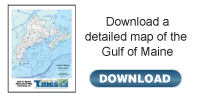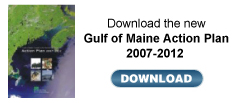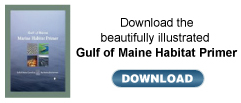Book Review
Atlantic Coast Beaches
Reviewed by Lee Bumsted
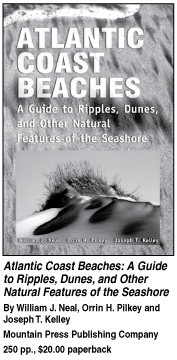 Many of us return year after year to a particular coastal beach.
This special stretch of sand or stones could be near our home
or our summer vacation spot, or perhaps it is a day-trip destination.
If we’re lucky, we get to visit it not just in the summer,
but in all seasons. For me, that beach is found at Popham Beach
State Park in Phippsburg, Maine. Many of us return year after year to a particular coastal beach.
This special stretch of sand or stones could be near our home
or our summer vacation spot, or perhaps it is a day-trip destination.
If we’re lucky, we get to visit it not just in the summer,
but in all seasons. For me, that beach is found at Popham Beach
State Park in Phippsburg, Maine.
Our favorite beach is different every time we see it. We may
wonder why it has a new contour, or notice that its surface has
beautiful ripple patterns. It could be covered by interesting
wrack or foam of unknown origin. Dunes may have shifted or new
salt-tolerant plants taken root. The sand may even sing to us.
In Atlantic Coast Beaches: A Guide to Ripples, Dunes, and
Other Natural Features of the Seashore, William Neal, Orrin
Pilkey and Joseph Kelley write: “We love the beach, the critters
it holds and nurtures, and the complex mechanisms that make it
work. We’re intrigued by the physical processes that one
can observe and understand if one learns how to read the beach.”
In this engaging book, they help us appreciate our own beach and
give us tools to be more attentive observers of the forces at
work on it.
Neal, Pilkey, and Kelley explain beach influences as large
as geologic setting, tides, and storms and as small as the microscopic
organisms that live between grains of sand. They describe processes
that occur over long periods of time and others whose evidence
is erased with the incoming tide. The chance to see short-lived
seasonal features, such as frozen wave swash (the water and materials
carried onto the shore when a wave breaks) or an ice foot (a narrow
strip of ice formed on the shore by the gradual freezing of wave
spray) is a good reason to visit the shore in the winter months;
Popham Beach and other beaches along the Gulf of Maine are ideal
places to find such formations.
The chapter “Can You Read a Beach?” contains some
great tips on being a beach detective: how to observe naturally
occurring foam, wind structures in sand, sand layers, foot-sucking
“bubbly sand,” and patterns left by invertebrates and
plants. The authors “recommend that you put down your beer,
binoculars, fishing pole, or the novel you brought to the beach
and make some close-up beach observations.” In another chapter
they discuss the variety of minerals and shells that make up sand,
and how a handful of sand can tell much about the beach’s
origins.
Because one intention of this book is to take people beyond
looking for seashells, shells are described primarily in the context
of how they came to be on a given beach. Fossil shells are more
common than might be expected. They originate in ancient rock
on the sea floor. As an interesting aside, the mechanism that
causes 80 to 90 percent of shells to rest on the beach concave
side down is revealed.
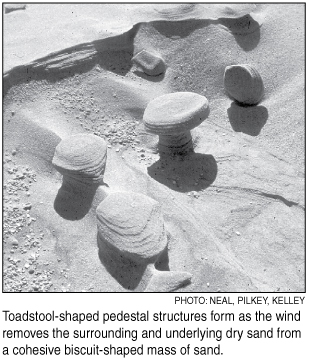 The authors are able guides to this beach-reading. All three
have written books on environmental problems facing East Coast
beaches but have teamed up here to focus on natural processes.
William Neal is professor emeritus and past chairman of the Department
of Geology at Grand Valley State University in Michigan. Orrin
Pilkey is professor emeritus in the Nicholas School of the Environment
and Earth Science at Duke University in North Carolina. Joseph
Kelley is a Maine native who is chairman of the Department of
Earth Science at the University of Maine. The authors are able guides to this beach-reading. All three
have written books on environmental problems facing East Coast
beaches but have teamed up here to focus on natural processes.
William Neal is professor emeritus and past chairman of the Department
of Geology at Grand Valley State University in Michigan. Orrin
Pilkey is professor emeritus in the Nicholas School of the Environment
and Earth Science at Duke University in North Carolina. Joseph
Kelley is a Maine native who is chairman of the Department of
Earth Science at the University of Maine.
While the authors’ primary focus is natural processes,
they do write that “beaches are indestructible, except when humans get involved.” They describe the negative consequences
of trying to maintain beaches in fixed locations in front of buildings
sited too close to the waterfront. Shore-hardening structures
such as seawalls cut beaches off from replenishing sand. Beach
nourishment programs are also temporary solutions, as factors
that led to the original sand loss are still present. For instance,
the beach at Camp Ellis, Maine, has been artificially replenished
eight times since 1969. Importing beach material has the further
ill effect of smothering native invertebrates and plants.
Many photographs and diagrams complement the text and a helpful
glossary is included. Canadian readers should note that the beaches
used as examples are limited to those found between Maine and
Florida.
Oh, about those singing beaches. It’s a sound sometimes
made when dry sand grains of similar size slide against each other,
as when children or playful adults shuffle along. It’s just
one of the many things readers will know to look and listen for
on their next walk along their favorite beach.
Lee Bumsted writes on conservation and outdoor recreation
topics from South Portland, Maine.
|






